Growing potatoes in a greenhouse! Did you know you can grow potatoes in a special house made of glass called a greenhouse? A greenhouse is a house where it’s always warm, and plants can grow all year, even when it’s cold outside.
It’s really fun and not too hard! Even if you haven’t grown plants before, you can do it. In a greenhouse, you can make sure your potatoes get just the right amount of warm, light, and water.
You’ll learn everything you need to know to make your potatoes grow big and healthy in your glass house!
Let’s start Growing Potatoes in a Greenhouse!
Choosing the Right Variety of Potatoes
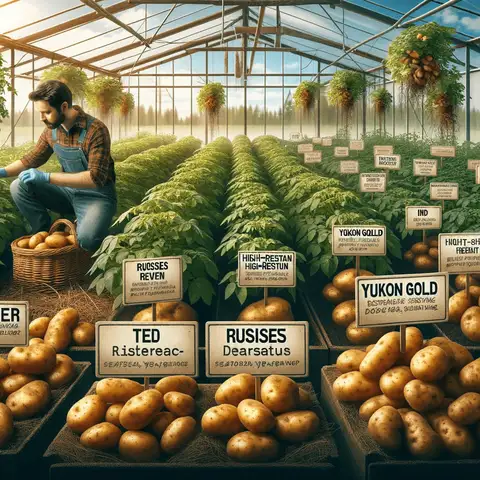
When you want to grow potatoes in a greenhouse, the first step is choosing the right kind of potatoes. Just like apples, there are many types of potatoes. Some potatoes are big, some are small, and they come in colors like white, yellow, and even purple!
Different Types of Potatoes for Your Greenhouse:
- Early Potatoes: These potatoes grow fast! You can pick them up in early summer.
- Maincrop Potatoes: They take longer to grow, but you get more potatoes in late summer or early fall.
- Fingerling Potatoes: These are small and look like fingers.
But not all potatoes grow the same in a greenhouse. You want potatoes that:
- Don’t get sick easily: Some potatoes are strong and don’t get sick from bugs or diseases.
- Give you lots of potatoes: We call these “high-yield” because you get lots of potatoes from each plant.
Tips for Picking the Best Potatoes for Your Greenhouse:
- Ask Gardeners or Farmers: They know a lot about potatoes and can tell you which types grow well in a greenhouse.
- Look for Disease Resistance: Check the seed packet or ask at the store for potatoes that don’t get sick easily.
- Try Different Types: Sometimes, it’s fun to try a few kinds and see which ones grow the best in your greenhouse.
Preparing the Greenhouse Environment
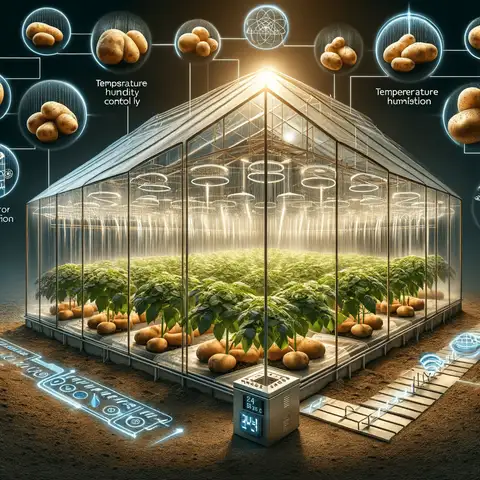
Now that you have chosen the best potatoes, it’s time to make your greenhouse the perfect place! But to grow happy potatoes, we must set up the greenhouse just right.
Here’s how to make your greenhouse perfect for potatoes:
- Temperature Control: The best temperature is between 60°F and 70°F. In the daytime, it’s okay if it gets a little warmer, but not too hot! You can use a thermometer to check the temperature.
- Keep the Air Just Right: Potatoes also need the air to be a bit moist but not too wet. This is called humidity. If your greenhouse is too dry, you can spray some water to make the air moist. If it’s too wet, you might need to open a window or use a fan.
- Let in the Light: Potatoes love sunlight! Make sure they get enough light but only a little direct sun. Sometimes, you can use a shade cloth to protect them from too much sun.
- Clean and Tidy: Keep your greenhouse clean. This helps stop bugs and sicknesses that can hurt your potatoes.
Soil Preparation and Planting
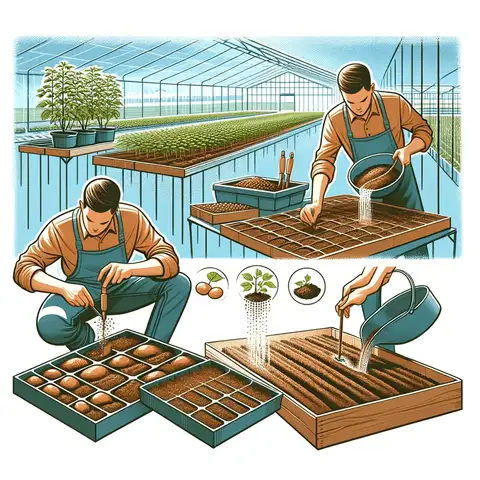
Now, let’s get the soil ready and plant your potatoes. Good soil is like a comfy bed for plants.
Here’s how to prepare the soil and plant your potatoes:
Making the Soil Just Right:
- Mix the Soil: Use a mix of garden soil, compost, and maybe a bit of sand. This makes the soil light and fluffy so that roots can grow easily.
- Check the Soil is Not Too Acidic: Potatoes like soil that’s not too sour (acidic) or too bitter (alkaline). You can get a soil test kit from a garden store to check this.
Planting the Potatoes:
- These potatoes are for planting, not eating. They have little bumps called ‘eyes’. New plants will grow from these eyes.
Cutting the Potatoes:
- If your potato is big, cut it into smaller pieces. Each piece needs one or two eyes.
- Be careful with scissors or ask an adult to help.
Let the Pieces Dry:
- After cutting, leave them outside for a day or two. This helps them get ready to grow.
Time to Plant:
- Make small holes in your soil, about as deep as your finger.
- Put one potato piece in each hole.
- Cover them with soil and pat them gently.
Give Them Space:
- Plant them a bit apart, like steps in a hopscotch game.
Watering Your New Potato Plants:
- After planting, give them some water.
Watering and Nutrient Management
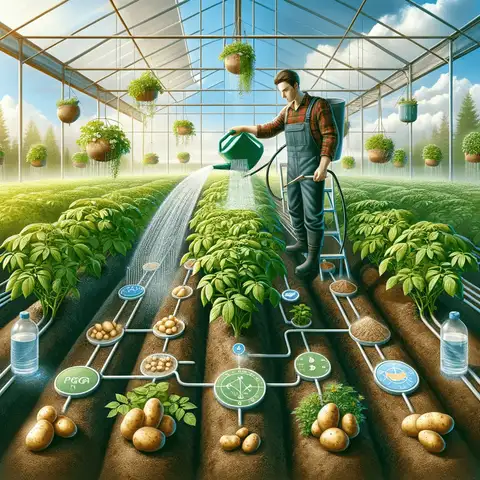
Now that your potatoes are planted let’s make sure they get enough water and food to grow big and healthy. But it’s important to give them the right amount!
Watering Your Potato Plants:
How Much Water?
- Potatoes like to stay moist but not too wet. Try to keep the soil damp like a wrung-out sponge.
- If the top inch of the soil feels dry, it’s time to water them.
When to Water?
- Morning is Best: Watering in the morning is best because it gives the plants time to drink up before it gets hot.
- Be Careful Not to Overwater: Too much water can make the potatoes rot.
Feeding Your Potato Plants:
Using Fertilizers:
- Start with Compost: When you plant your potatoes, mixing in some compost gives them a good start.
- Add Fertilizer Later: After a few weeks, you can add a vegetable fertilizer.
Natural Nutrients:
- Use Organic Options: You can use things like seaweed extract or fish emulsion.
- Remember to Follow Directions: Whether you use a store-bought fertilizer or a natural one, always follow the instructions on how much and how often to use it.
Pest and Disease Control in a Greenhouse
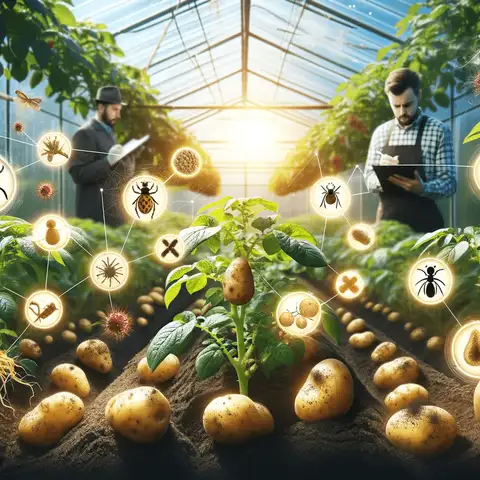
Growing potatoes in a greenhouse is fun, but sometimes bugs and plant sicknesses can be a problem.
Common Pests and Diseases in Greenhouse Potatoes:
Pests to Watch Out For:
- Aphids: These are tiny bugs that can suck the juice from your potato plants.
- Potato Beetles: These beetles and their babies (larvae) eat the leaves of potato plants.
Diseases to Be Aware Of:
- Blight: This is a sickness that makes spots on the leaves and can make the whole plant sick.
- Fungus Problems: Sometimes, mushrooms or mold can grow, especially if it’s too wet.
How to Stop These Problems:
Organic Solutions:
- Neem Oil: This is a natural oil that can help stop many bugs and sicknesses.
- Ladybugs: Believe it or not, ladybugs eat aphids. You can get ladybugs and let them live in your greenhouse to help.
- Clean Up: Keep your greenhouse clean. Remove any dead leaves or plants because they can attract bugs or sickness.
Chemical Solutions:
- Insecticides and Fungicides: These are special chemicals that can kill bugs or stop sicknesses. Always read the instructions and use them safely.
- Be Careful with Chemicals: If you use chemicals, make sure they are safe for greenhouses and food plants like potatoes.
Monitoring Growth and Environmental Conditions
Let’s learn how to check on your potato plants and adjust their greenhouse home as they grow.
How to Monitor Your Potato Plants:
Look at the Leaves and Stems:
- Healthy Leaves: They should be green and strong. If they look yellow or droopy, your plant might need more water or food.
- Stem Growth: The stems should be growing tall and strong.
- Check the Soil: Use your finger to feel the soil. Remember, it should be like a wrung-out sponge, not too dry or too wet.
- Watch for Flowers: Potato plants make flowers too! When you see flowers, it means your potatoes are growing underneath.
Adjusting the Greenhouse for Growing Potatoes:
- Temperature Changes: As your potatoes grow, they need less heat. You can adjust the temperature in your greenhouse if it has heaters or fans.
- Managing Light: If it’s very sunny, use a shade cloth to protect your plants from getting too much sun.
- Air Flow is Important: Good airflow helps keep your plants healthy. You can open windows or use fans to keep the air moving.
- Keep It Clean: Regularly clean your greenhouse and remove any dead leaves or plants.
Harvesting and Storage
After all your care and hard work, it’s time to pick your potatoes. But how do you know when they are ready? And once you pick them, how do you keep them fresh? Let’s find out!
Knowing When Your Potatoes Are Ready to Harvest:
- Look at the Leaves: When the leaves turn yellow and start to sag, it’s a sign that your potatoes might be ready.
- Check the Calendar: Usually, potatoes are ready about 10 weeks after planting. But it depends on the type of potato.
- Do a Little Test Dig: Gently dig around the edge of a plant to see if you can feel any potatoes. If they are a good size, they might be ready.
How to Harvest Your Potatoes:
- Be Gentle: Use a small shovel or a gardening fork to dig around the plant carefully. Be careful not to poke or cut the potatoes.
- Dig Them Up: Gently lift the plant and find the potatoes in the soil.
- Brush Off the Soil: Brush off the extra soil, but wait to wash them. Washing can make them spoil faster.
Storing Your Potatoes:
- Cure Them First: Let them sit in a cool, dry place for a couple of days. This helps the skin get a little tougher and makes them last longer.
- Find a Cool, Dark Place: Potatoes like to be stored in a cool, dark, and dry place. A basement or a cupboard away from light is good.
- Check Them Often: Sometimes, a potato might go bad. If you find one, take it out so the others stay good.
By harvesting and storing your potatoes correctly, you can enjoy them for a long time. Imagine eating potatoes that you grew yourself!
Why Growing Potatoes in a Greenhouse
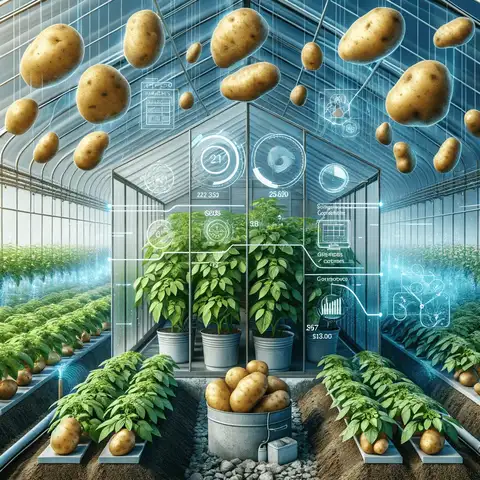
Growing potatoes in a greenhouse is not just fun, but it has lots of good things about it. Here is why:
- Year-Round Growing: In a greenhouse, you can grow potatoes all year, no matter the weather outside. This means you get fresh potatoes even in winter!
- Control Over the Environment: You can control the temperature and humidity in a greenhouse.
- Fewer Pests and Diseases: Greenhouses can protect potatoes from bugs and plant sicknesses that are outside.
- Better Growth Conditions: You can make the soil in your greenhouse just right for potatoes.
- Saves Water and Soil: Growing in a greenhouse can use less water than growing outside.
- Fun and Educational: Growing your potatoes is a way to learn about plants and gardening. It’s fun for kids and adults!
- Eco-Friendly: Using a greenhouse can be good for our planet.
- Safe from Animals: In a greenhouse, animals like rabbits or deer can’t get to your potatoes. This keeps your crop safe.
- Grow Different Types: You can grow different kinds of potatoes that might not grow outside in your area.
- Fresh and Healthy: Potatoes from your greenhouse are fresh and don’t need to travel far to get to your table.
Challenges and Solutions in Greenhouse Potato Farming
Let’s look at some common problems with greenhouse potatoes and how to fix them.
Common Challenges and Their Solutions:
Too Much or Too Little Water:
- Problem: Potatoes prefer to be wet and dry.
- Solution: Check the soil often. If it’s dry, water your plants. If it’s too wet, let it dry out a bit before watering again.
Not Enough Light or Too Much Heat:
- Problem: Potatoes need light, but too much heat can be bad.
- Solution: Use a shade cloth if it’s too sunny. Make sure your greenhouse has good air flow to keep the temperature just right.
Pests and Diseases:
- Problem: Bugs and sicknesses can hurt your potatoes.
- Solution: Keep your greenhouse clean. Use natural or safe chemical solutions to keep bugs and diseases away.
Poor Soil Quality:
- Problem: Potatoes need good soil to grow.
- Solution: Mix compost into your soil. Test your soil to make sure it has the right balance for potatoes.
Space Problems:
- Problem: Potatoes need room to grow.
- Solution: Don’t plant them too close together. Give each potato plant enough space to spread its leaves and roots.
Tips for Successful Greenhouse Potato Farming:
- Keep Learning: Read books, watch videos, or talk to other gardeners to learn more.
- Be Patient: Growing potatoes takes time. Don’t rush. Let them grow at their own pace.
- Have Fun: Remember, gardening is fun! Enjoy your time with your plants.
Conclusion
We’ve learned so much about growing potatoes in a greenhouse!
It’s important to remember words like sustainable farming, greenhouse benefits, and efficient cultivation.
Additional Resources
Here are some ways to keep learning:
- Books: Look for books about greenhouse gardening and growing potatoes. Your local library or bookstore might have some great ones.
- Websites: There are many websites with tips and tricks for gardeners.
- Videos: Watch videos online from experienced gardeners who share their knowledge.
- Local Gardening Groups: Join a gardening club or group in your area.
- Gardening Courses: Some places offer courses on gardening.













